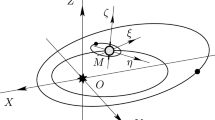Abstract
The results of a simultaneous solution for the orbital elements of Moon and planets are given and their derivation is discussed. A modern Cowell integrator is used for orbit computations, and least-squares fits are made to some 40000 optical observations taken since 1913. The model includes relativistic terms, the leading zonal harmonics of Earth and Moon, the precession of the lunar equator, and the tidal couple between Earth and Moon. The tidal term in the Moon's mean longitude is found to be −19″±4″ per century squared. The solution also yields an extrapolation of the atomic time scale back to 1912.5. At that time, the difference between atomic and ephemeris time is about 6±2 s. Lunar declinations observed by the Washington transit circles, after receiving limb corrections and thus with respect to the center of Watts' reference sphere, are smaller than computed values by 0″.33±0″.01. It is found that solar oblateness cannot quite be determined with optical data covering about 50 yr, butJ 2 is unlikely to be much larger than 10−5. The advance of Mercury's perihelion is verified to within our resolution of 2″ per century to match that predicted by Einstein.
The solution presented here is believed to be the only simultaneous improvement of the orbits of Moon and planets. This simultaneity is found to be an essential feature in separating the Moon's mean motion, the lunar tidal deceleration, and the corrections to the Earth rotation rate. It is now possible to refer all astronomical events of the past 60 yr to a time with uniform rate, namely the atomic clock system. Considering the long baseline, this model should facilitate the prediction of fast variables, such as the lunar longitude, with considerably increased confidence. The planetary orbital elements compete with efforts of similar scope and accuracy at the Massachusetts Institute of Technology and the Jet Propulsion Laboratory.
Similar content being viewed by others
References
Adams, A. N. and Scott, D. K.: 1964, ‘Observations of the Sun, Moon, and Planets, Six-Inch Transit Circle Results’, U.S. Naval Obs. Circular, No. 103.
Adams, A. N. and Scott, D. K.: 1964,Ibid. ‘Observations of the Sun, Moon, and Planets, Six-Inch Transit Circle Results’, U.S. Naval Obs. Circular, No. 105.
Adams, A. N. and Scott, D. K.: 1965,Ibid., ‘Observations of the Sun, Moon, and Planets, Six-Inch Transit Circle Results’, U.S. Naval Obs. Circular, No. 108.
Adams, A. N. and Scott, D. K.: 1967,Ibid. ‘Observations of the Sun, Moon, and Planets, Six-Inch Transit Circle Results’, U.S. Naval Obs. Circular, No. 115.
Adams, A. N. and Scott, D. K.: 1968,Ibid., ‘Observations of the Sun, Moon, and Planets, Six-Inch Transit Circle Results’, U.S. Naval Obs. Circular, No. 118.
Adams, A. N. and Scott, D. K.: 1968, ‘Results of Observations Made with the Six-Inch Transit Circle 1956–1962’,Publ. U.S. Naval Obs., Second Series, Vol.XIX, Part II.
Adams, A. N. and Scott, D. K.: 1969, ‘Observations of the Sun, Moon, and Planets, Six-Inch Transit Circle Results’, U.S. Naval Obs. Circular, No. 124.
Adams, A. N., Bestul, S. M., and Scott, D. K.: 1964, ‘Results of Observations Made with the Six=Inch Transit Circle 1949–1956’, Publ.U.S. Naval Obs., Second Series, Vol.XIX, Part I.
Adams, A. N., Klock, B. L., and Scott, D. K.: 1969, ‘Washington Meridian Observations of the Moon, Six-Inch Transit Circle Results 1925–1968’,Ibid. Publ.U.S. Naval Obs., Vol.XIX, Part III.
Ash, M. E., Shapiro, I. I., and Smith, W. B.: 1967, ‘Astronomical Constants and Planetary Ephemerides Deduced from Radar and Optical Observations’,Astron. J. 72, 338.
Brans, C. and Dicke, R. H.: 1961,Phys. Rev. 124, 925.
Brouwer, D.: 1952, ‘A Study of the Changes in the Rate of Rotation of the Earth’,Astron. J. 47, 125.
Brouwer, D.: 1959, ‘Solution of the Problem of Artificial Satellite Theory Without Drag’,Astron. J. 64, 378.
Brouwer, D. and Clemence, G. M.: 1961, ‘Orbits and Masses of Planets and Satellites’, inPlanets and Satellites, (ed. by G. P. Kuiper and B. M. Middlehurst), Univ. of Chicago Press.
Chernykh, L. I. and Chernykh, N. S.: 1967, ‘Observations of Minor Planets and Pluto made at the Crimean Astrophysical Observatory’,Bull. Inst. Theor. Astron. 11, 154.
Cohen, C. J. and Hubbard, E. C.: 1962, ‘A Nonsingular Set of Orbit Elements’,Astron. J. 67, 10.
Cohen, C. J., Hubbard, E. C., and Oesterwinter, C.: 1967, ‘New Orbit for Pluto and Analysis of Differential Corrections’,Astron. J. 72, 973.
Explanatory Supplement to the Astronomical Ephemeris and the American Ephemeris and Nautical Almanac: 1961, Her Majesty's Stationery Office.
Hagihara, Y.: 1962, ‘Recommendations on Notation of the Earth Potential’,Astron. J. 67, 108.
Hammond, J. C. and Watts, C. B.: 1927, ‘Results of Observations with the Six-Inch Transit Circle 1909–1918’,Publ. U.S. Naval Obs., Second Series, Vol.XI.
O'Handley, D. A.: 1968, ‘Card Format for Optical and Radar Planetary Data’, Jet Propulsion Laboratory Technical Report 32-1296.
Klock, B. L. and Scott, D. K.: 1970, ‘Observations of the Sun, Moon, and Planets, Six-Inch Transit Circle Results’, U.S. Naval Obs. Circular, No. 127.
Morgan, H. R.: 1933, ‘Results of Observations with the Nine-Inch Transit Circle, 1913–1926’,Publ. U.S. Naval Obs., Second Series, Vol.XIII.
Morgan, H. R. and Scott, F. P.: 1948, ‘Results of Observations made with the Nine-Inch Transit Circle, 1935–1945’,Ibid. Publ. U.S. Naval Obs., Vol.XV, Part V.
Peters, C. F.: 1964, Private communication.
Seidelmann, P. K.: 1967, Private communication.
Shapiro, I. I.: 1970, Private communication.
The American Ephemeris and Nautical Almanac for the Year 1970: 1968, U.S. Government Printing Office.
Watts, C. B. and Adams, A. N.: 1949, ‘Results of Observations Made with the Six-Inch Transit Circle 1925–1941’,Publ. U.S. Naval Obs., Second Series, Vol.XVI, Part I.
Watts, C. B., Scott, F. P., and Adams, A. N.: 1952, ‘Results of Observations Made with the Six-Inch Transit Circle 1941–1949’,Ibid. Publ. U.S. Naval Obs., Vol.XVI, Part III.
Author information
Authors and Affiliations
Rights and permissions
About this article
Cite this article
Oesterwinter, C., Cohen, C.J. New orbital elements for Moon and planets. Celestial Mechanics 5, 317–395 (1972). https://doi.org/10.1007/BF01228434
Received:
Issue Date:
DOI: https://doi.org/10.1007/BF01228434




